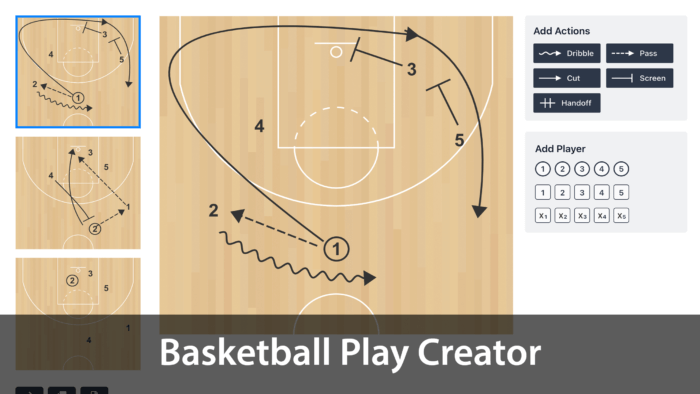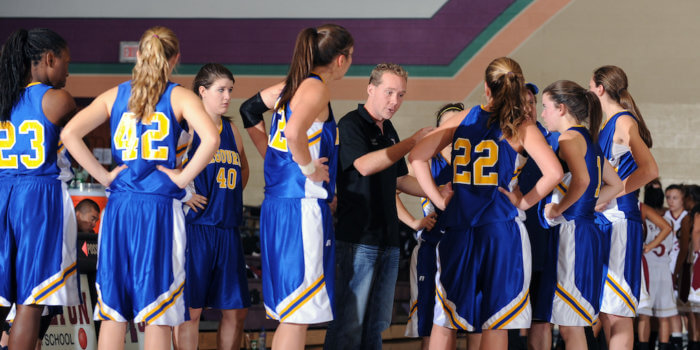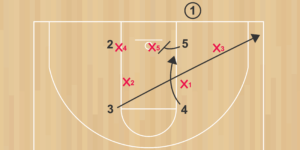When we watch our favorite NCAA, NBA, and WNBA teams run beautiful offensive sets, it’s tempting to think we can install those with the youth basketball teams that we coach. However, with youth basketball, simple is often better. Your players likely do not understand the nuances of offense, reads, concepts, and third or fourth options on plays – yet.
Keeping it simple allows your players to focus on mastering fundamentals, grasping the basics of the game, and learn from the mistakes they make along the way.
Table of Contents
How to Introduce First Plays for Youth Teams
When you are first introducing plays for younger athletes, one strategy to use is whole-part-whole.
First, show your team the entire play, explaining the basic concepts of whatever you are showing them. Then, start breaking the play down part-by-part – slowly. Finally, let them run it 5 on 0 before introducing the defense.
Sometimes, the best way for your team to understand the offense is to teach it in 5 on 5, stopping play in order to explain reads, reactions, and the play in general.
There’s a lot of debate in youth circles about what youth teams should be running on offense. Some believe youth players should just be taught motion offense without any real plays being called. Others believe the structure of plays help players understand the game better. A lot will depend on the skill level and basketball IQ of your team.
Easy Plays Against Man Defense
1. Five Out Pass and Cut
This is a simple, foundational offense that can be run with youth teams. It’s a very popular way to teach the game, spacing, cutting, passing, and game reads
Player Roles & Requirements:
- Each player plays every spot on the floor, so there aren’t positions when you run this offense.
- This is a great way to teach players to read the game, understand basic concepts, and play from every spot on the floor.
Instructions:
- 1 passes to 3.
- As soon as 1 passes, they basket cut hard to the rim. 1 wants to get their head under the rim and not end their cut too early.
- The other players are filling the open spots.
- 2 replaces 1
- 4 replaces 2
- 1 replaces 4
- 3 passes to 2.
- After 3 passes to 2, 3 cuts hard to the rim.
- 5 replaces 3.
- 3 replaces 5.
- 2 passes to 4.
- 2 cuts hard to the rim.
- 5 replaces 2. 3 replaces 5. 2 replaces 3.
- 4 passes to 1 in the corner. The same rules apply.
- 4 cuts to the rim (and then the open spot).
- 5 replaces 4. 3 replaces 5. 2 replaces 3.
- The motion continues.
Coaching Points:
- After each pass, the passer must cut hard to the rim
- Players fill up to the next available spot
- You should only have one person cutting to the rim at a time
2. Five Out Pass and Screen Away
This is a simple action to get your players passing and screening
Player Roles & Requirements:
- This play teaches all 5 players to do the same types of actions and is catered to “positionless” basketball.
- This is a great way to teach all players, regardless of position, some of the simple reads in basketball.
Instructions:
- 1 passes to 3.
- 1 screens away for 2.
- 2 comes off the screen and replaces 1.
When your players get this action down, the cutter who receives the screen (2 in this frame) and also cut to the rim sometimes.
- 3 passes to 2 (who just came off the screen from 1).
- After the pass, 3 immediately screens away for 5.
- 5 comes off the screen and then the pass and screen away motion continues until a shot or drive opportunity occurs for the offense.
Coaching Points:
- After every pass, the player must cut away from the direction they pass to set a screen for that player.
- The screener should jump stop and land on both feet when they set the screen.
- The cutter should wait until the screener is set before cutting.
- As players progress and develop, they can also come off the screens and go to the rim instead of just popping out.
3. Shallow
Shallow is a simple set to get your team penetrating the defense with the dribble.
Player Roles & Requirements:
- 1, 2, and 3 should be your best drivers and playmakers
- They need to be able to beat their man off the dribble, score inside, and pass to open teammates
- 4 and 5 should be your inside players who can finish layups.
Instructions:
- The play starts with 1 passing to 3.
- After the pass, 1 "shallow cuts" (see diagram) the same way they passed.
- After 1 cuts through, 3 drives to the rim looking to score or pass the ball to an open teammate.
- If 2, 5, or 4's defender help on the drive, 3 looks to make the pass to them.
- The most open pass will commonly be to 2.
- Now, the motion continues.
- 3 "shallow cuts" to the same side they passed on and now it's 2's turn to drive the ball and make a read.
Coaching Points:
- Whenever a player drives and kicks it out, they must shallow cut and get out of the middle as soon as possible. This opens up more space for the next driver.
- The player who is driving should “drive to score”. This doesn’t mean they force the play, but the harder they drive, the more opportunities will present themselves for kick outs and drop off passes to the post players.
- Post players should have their butts to the baseline.
4. NASCAR
This ball screen play didn’t have a name until one of my teams labeled it “NASCAR” because it scored points so quickly.
Player Roles & Requirements:
- 2 should be a good decision maker and ball handler
- 5 should be a good finisher inside
- 1 should be a good shooter
Instructions:
- 1 passes to the wing.
- 5 sets a UCLA screen for 1.
- If 1 is open, 2 can pass it to them.
- 5 then sets a ball screen for 2.
- While this is happening, 1 is coming off a double screen from 3 and 4.
- The double screen helps 1 to get open AND it takes away help from 5 rolling to the rim.
- 2 makes the right read:
- keep it themselves and score
- hit 5 in the post
- kick out to 1 on the perimeter
Coaching Points:
- If the first pass to 1 is available, make that pass to steal points
- 1 should wait until 2 and 5 start their pick-and-roll action before coming off the screen; timing is very important
Easy Basketball Plays Against Zone Defense
1. Zone X
Zone X can be run as a play against zone defense. What makes this play effective is that it is a continual pattern that attacks the zone intelligently.
Player Roles & Requirements:
- 1, 2, and 3 are you guards/forwards. These players should be able to make good passes and make open shots from the perimeter.
- 4 and 5 are post players. They must be able to make a layup, catch the ball in the high post, and make a good decision when they catch.
Instructions:
- 1 passes to 3.
- The opposite post player (4 in this frame) flashes high with hands out to the elbow/high post area.
- 3 is looking to pass to 4 in the high post.
- When 4 catches, they have a few options:
- Shoot it
- High-low pass to 5
- Skip opposite to 2
- If 3 can't pass it to 4, they reverse it back to 1.
- 1 then reverses to 2.
- Now, 5 is the opposite post so it is their turn to flash high.
- 4 cuts back to their original spot.
- 2 is trying to pass to 5 in the high post.
- Now, the motion/continuity/pattern continues.
Coaching Points:
- 4 and 5 should be flashing from behind the zone – this makes it harder to defend
- On every catch by 4 and 5, the other players should be getting in open windows so they can receive a pass
- If the ball goes to the short corner/corner, the high post player should dive to the rim for an easy layup.
2. Four Out Pass & Cut
This simple 4-Out zone attack puts players in positions to attack gaps, cut through the zone to apply pressure, and flash into open spots.
Player Roles & Requirements:
- The perimeter players (1, 2, 3, and 4) should be your most skilled players
- 5 should be a post-type player who can also catch in the high post and score or find open cutters
Instructions:
- 1 passes to 2.
- 1 cuts to the rim.
- 3 and 4 fill up to the next spots (this happens continuously in the offense)
- After 1 cuts, 5 flashes into the high post gap.
- 1 empties out and cuts to take 4's spot.
- 2's first option is 5, but they can also reverse it to open players in the gaps.
- If 5 catches it, the defense will usually crowd around them and be sucked in.
- This is a great opportunity to kick out to 1, 4, or 3.
- If your team is more advanced - 1, 4, or 3 can also look to cut to the rim when 5 catches.
Coaching Points:
- When cutting, players can sometimes stop their cut early and “hook” into an open gap
- Players should try to be spaced out enough so that more than 1 zone defender is focused on them
- Instruct players to be patient, use ball screens, and not force the issue against a zone
3. Zone Loop
Zone Loop is a quick hitter set that uses cutting and a ballscreen to attack gaps in a zone.
Player Roles & Requirements:
- 3 should be a good shooter
- 2 should be able to use a ball screen well and make good decisions
Instructions:
- 1 dribbles at 3.
- This dribble initiates 3 cutting behind the defense and topping up at the top of the key.
- 1 makes sure x2 is guarding them.
- 1 passes to 3.
- On 3's catch, 4 is sprinting to set a ballscreen on x2.
- 3 uses the ballscreen.
- When 3 is doing this, 2 spaces to the corner to put pressure on x4.
- 4 rolls to the rim.
- 3 reads x4:
- if x4 takes 3, he kicks it out to 2.
- if x4 stays on 2, 3 drives it
- if 4 can seal x5, 3 looks for 4 inside
Coaching Points:
- 1 must make the wing defender in the zone commit to him before making the reversal pass to 2
- When 2 uses the ball screen, they must make the correct read: kick out to 3, pass to the roll man, or keep the ball to themselves
Easy Baseline Out of Bounds Plays
1. Screen Away
This extremely simple inbounds play will help you to get the ball thrown in without turning it over and maybe score some points.
Player Roles & Requirements:
- 5 and 4 are your post players/inside players who can finish at the rim
- 2 and 3 are you guards; 2 should be your best shooter
Instructions:
- 3 screens away for 2.
- 5 screens away for 4.
- Both of these actions are happening at the same time.
- If 2 or 4 are not open, 3 pops out and is the safety.
- 1 looks to throw it to 3.
- 1 can also look at 5 flashing after screening.
Coaching Points:
- If nothing is available immediately on the inbounds play, look for 3 as the safety valve over the top
- If teams switch, 5 rolling to the rim will be open if they seal their defender
2. Pick the Picker
This is a classic set that has gotten many teams layups over the years. The pick-the-picker action confuses the defense and leaves open opportunities at the rim.
Player Roles & Requirements:
- 3 should be a good shooter
- 2 should be able to use a ball screen well and make good decisions
Instructions:
- The play begins with 5 setting a screen for 3.
- If 3 is open, 1 can make the pass to 3.
- If 3 doesn't get it, they pop out to the corner.
- As 5 was setting the screen earlier, 4 starts to work their way up to set a screen for 5.
- This is called pick-the-picker because 4 is screening for the player who just set the screen. This makes it very difficult for x5 to guard everything well.
- 4 also slips to the rim for added rim pressure.
- If nothing is open, 2 cuts to a spot on the floor that is easy for 1 to inbound to. 2 is the safety valve.
Coaching Points:
Timing is very important with this set – especially for 4. If 4 goes too soon to set the second screen, it won’t work because teams can easily switch. If 4 goes too slowly, x5 will be able to recover from the first screen and handle this second screen as well.
Easy Sideline Inbounds Play
1. Solo
“Solo” is a simple and effective set to create a two-man game between a shooter and post player off a sidelines out of bounds situation.
Player Roles & Requirements:
- 2 is your best shooter
- 5 is your best post player
Instructions:
- 5 screens for 2 (best shooter).
- 3 passes to 2 for the shot if they are open.
- 4 screens 1 as a safety valve in case 2 doesn't get open.
- 4 spaces out to the wing. 1 spaces to top of the key. 3 steps inbounds to the wing.
- If 2 doesn't have the shot, they can look to pass inside to 5.
Coaching Points:
- 5 sets a screen for 2 to start the play. 2 needs to be sprinting off this screen.
- If 2 is open for the three, he takes it.
- If he’s not open, 2 can pass to 5 in the post.
- There shouldn’t be a lot of defensive help to prevent 5 from getting a decent post touch (especially if x5 helped out 2 cutting to the corner)
Final Thoughts
If you want to draw up your own plays, check out the Play Creator App. It allows you to design plays with an easy Drag & Drop interface. Give it a try!
If you want to educate yourself further, you can learn how to draw up plays here or find more inbound plays here.







